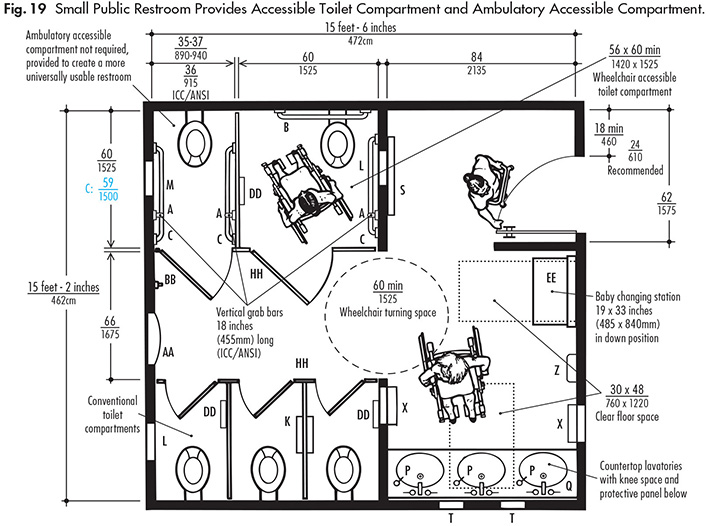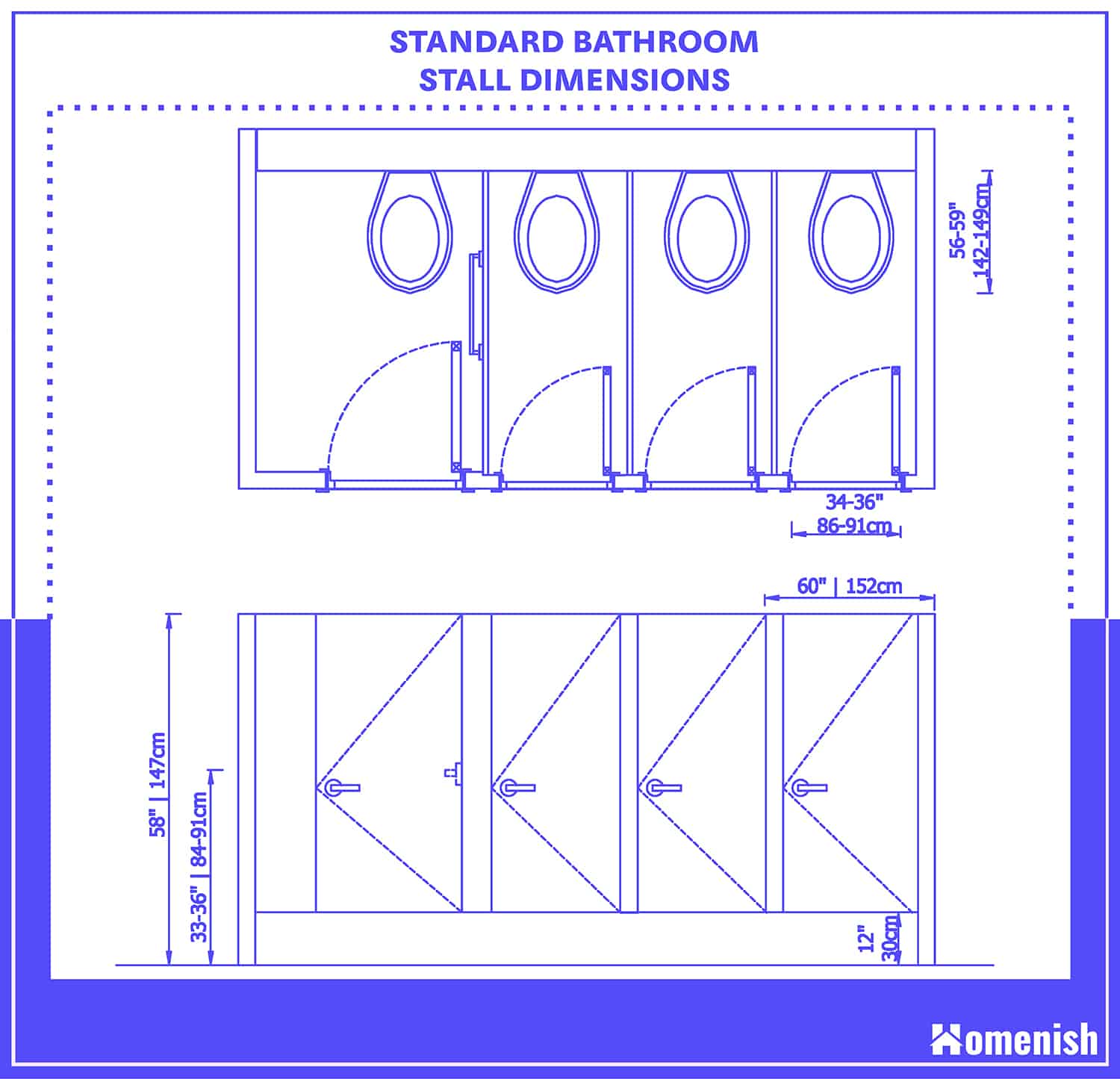Essential Considerations for Commercial Bathroom Stall Design

Commercial bathroom stall design plays a crucial role in creating a functional, hygienic, and aesthetically pleasing environment for users. Beyond basic functionality, a well-designed stall ensures accessibility, safety, and comfort, enhancing the overall user experience.
Accessibility and Universal Design
Accessibility in commercial bathroom stall design is paramount, ensuring that all users, regardless of their abilities, can utilize the facilities comfortably and independently. The Americans with Disabilities Act (ADA) provides comprehensive guidelines for accessible bathroom design, encompassing aspects such as stall size, door width, grab bars, and toilet height.
- ADA Compliance: Adhering to ADA guidelines ensures that stalls are accessible to individuals with disabilities. This includes provisions for wheelchair users, such as minimum stall width of 60 inches, clear floor space, and accessible toilet height.
- Universal Design Principles: Universal design goes beyond ADA compliance, aiming to create spaces that are usable and accessible to the widest range of users possible. This encompasses features like lever-style door handles, contrasting colors for visual clarity, and clear signage for wayfinding.
Materials Selection
Material selection is crucial in commercial bathroom stall design, impacting durability, hygiene, and aesthetics.
- Durability: Stalls should be constructed from materials that can withstand heavy use and resist damage, such as moisture, impact, and cleaning agents. Durable materials like stainless steel, solid plastic, and certain types of laminate are commonly used for stalls, ensuring longevity and reducing maintenance costs.
- Hygiene: Choosing materials that are easy to clean and maintain is essential in commercial bathroom settings. Non-porous surfaces are preferred as they resist the growth of bacteria and mold. Materials like solid plastic and stainless steel are highly resistant to stains and can be easily disinfected.
- Aesthetics: While functionality is paramount, aesthetics also play a role in creating a positive user experience. Materials can contribute to the overall look and feel of the bathroom, with options ranging from sleek and modern to classic and traditional.
Safety and Comfort, Commercial bathroom stalls design
Creating a safe and comfortable environment is essential in commercial bathroom stall design.
- Stall Size: Adequate stall size is crucial for user comfort and safety. Stalls should provide sufficient space for users to move around comfortably, especially for individuals with mobility limitations.
- Lighting: Proper lighting is essential for safety and hygiene. Stalls should be well-lit, providing adequate illumination for users to see clearly and navigate safely.
- Ventilation: Ventilation is crucial for maintaining air quality and preventing the buildup of moisture and odors. Adequate ventilation systems should be installed to ensure a comfortable and hygienic environment.
Layout and Design
A well-designed bathroom stall layout prioritizes privacy, efficiency, and user comfort.
- Privacy: Stalls should provide adequate privacy, ensuring that users feel comfortable and secure. Solid partitions and doors that close completely are essential.
- Efficiency: The layout should be designed to optimize space and minimize congestion. This includes efficient placement of fixtures, such as toilets, sinks, and mirrors, and providing adequate clearance for movement.
- User Comfort: Stalls should be designed to maximize user comfort, considering factors like stall size, lighting, and ventilation. Comfortable seating and handrails can enhance the user experience.
Types of Commercial Bathroom Stalls and Their Applications: Commercial Bathroom Stalls Design
Commercial bathroom stalls are an essential element of any public or commercial space, offering privacy and functionality. Understanding the different types available and their suitability for various settings is crucial for creating a comfortable and practical restroom experience. This section will delve into the characteristics, applications, and considerations for each type of commercial bathroom stall.
Single-Person Bathroom Stalls
Single-person bathroom stalls are the most common type found in various commercial settings. They are designed to accommodate one user at a time, providing privacy and individual space.
These stalls are typically constructed with durable materials like stainless steel, fiberglass, or plastic laminate. They offer a cost-effective solution for most commercial spaces.
Advantages of Single-Person Bathroom Stalls:
- Cost-effective: Single-person stalls are generally the most affordable option, making them suitable for budget-conscious projects.
- Space-efficient: Their compact design allows for efficient use of space, particularly in smaller restrooms.
- Easy to clean and maintain: Smooth surfaces and durable materials make cleaning and maintenance relatively straightforward.
- Wide range of styles and finishes: Single-person stalls are available in various colors, materials, and designs to complement any aesthetic.
Disadvantages of Single-Person Bathroom Stalls:
- Limited privacy in high-traffic areas: In busy environments, noise from adjacent stalls can compromise privacy.
- Potential for congestion during peak hours: Limited stall availability can lead to queues and waiting times in high-traffic areas.
Multi-Person Bathroom Stalls
Multi-person bathroom stalls, often referred to as “family restrooms,” are designed to accommodate multiple users simultaneously. These stalls are commonly found in facilities where larger groups may need to use the restroom together, such as schools, restaurants, and family-oriented businesses.
Multi-person stalls typically feature a larger footprint and multiple toilet compartments, with shared sinks and countertops.
Advantages of Multi-Person Bathroom Stalls:
- Enhanced privacy for families and groups: They provide a more comfortable and private experience for families and groups, especially when traveling with young children.
- Increased capacity: Multi-person stalls can handle a larger volume of users, reducing wait times in high-traffic areas.
- Improved accessibility for families: They offer a convenient option for families with young children, allowing them to use the restroom together.
Disadvantages of Multi-Person Bathroom Stalls:
- Higher cost: Multi-person stalls are generally more expensive than single-person stalls due to their larger size and more complex construction.
- Increased space requirements: They require a larger footprint, which may not be feasible in all restrooms.
- Potential for noise and distractions: Multiple users within the same stall can lead to increased noise and distractions.
ADA-Compliant Bathroom Stalls
ADA-compliant bathroom stalls are designed to meet the accessibility requirements Artikeld by the Americans with Disabilities Act (ADA). These stalls are crucial for ensuring equal access for individuals with disabilities, promoting inclusivity and convenience in public restrooms.
ADA-compliant stalls must adhere to specific dimensions, clearances, and features to accommodate wheelchairs and other mobility aids. They typically include:
- Wider doorways: To allow easy wheelchair access.
- Grab bars: For support and stability.
- Lower toilet heights: To facilitate easier use for individuals with mobility limitations.
- Clear floor space: To accommodate wheelchair maneuvering.
Advantages of ADA-Compliant Bathroom Stalls:
- Improved accessibility for individuals with disabilities: They provide a safe and comfortable restroom experience for all users.
- Compliance with legal requirements: Meeting ADA standards ensures compliance with legal regulations, avoiding potential fines and lawsuits.
- Increased inclusivity: They create a more welcoming and inclusive environment for all users, regardless of their abilities.
Disadvantages of ADA-Compliant Bathroom Stalls:
- Higher cost: ADA-compliant stalls often require specialized materials and construction techniques, leading to increased costs.
- Space considerations: They require larger dimensions to meet accessibility requirements, potentially impacting the overall layout of the restroom.
Comparison of Commercial Bathroom Stall Types
| Stall Type | Key Features | Advantages | Disadvantages |
|—|—|—|—|
| Single-Person | Compact, cost-effective, easy to clean | Affordable, space-efficient, wide range of styles | Limited privacy, potential congestion |
| Multi-Person | Larger footprint, multiple compartments | Enhanced privacy, increased capacity, improved accessibility for families | Higher cost, increased space requirements, potential for noise |
| ADA-Compliant | Wider doorways, grab bars, lower toilet heights, clear floor space | Improved accessibility for individuals with disabilities, compliance with legal requirements, increased inclusivity | Higher cost, space considerations |
Trends and Innovations in Commercial Bathroom Stall Design

The landscape of commercial bathroom stall design is constantly evolving, driven by a confluence of factors including sustainability, technology, and user experience. This dynamic environment has given rise to innovative trends and solutions that prioritize hygiene, comfort, and eco-consciousness.
Sustainable Materials and Practices
Sustainable materials and practices are gaining significant traction in commercial bathroom stall design, reflecting a growing emphasis on environmental responsibility. This trend encompasses the use of recycled materials, low-VOC paints, and energy-efficient lighting solutions.
- Recycled Plastics: Recycled plastic is increasingly being incorporated into bathroom stall components, reducing the demand for virgin materials and minimizing environmental impact.
- Bamboo and Sustainable Wood: Bamboo and sustainably harvested wood are gaining popularity as alternatives to traditional materials like PVC. These materials are renewable and offer a natural aesthetic.
- Low-VOC Paints: Low-VOC paints contribute to improved indoor air quality and reduce the release of harmful chemicals into the environment.
- Energy-Efficient Lighting: LED lighting systems offer significant energy savings compared to traditional incandescent bulbs, reducing electricity consumption and promoting sustainability.
Smart Technology Integration
Smart technology is revolutionizing the commercial bathroom experience, enhancing user convenience and creating a more hygienic environment. This integration encompasses touchless fixtures, automated cleaning systems, and personalized lighting.
- Touchless Fixtures: Touchless faucets, soap dispensers, and flush systems minimize the spread of germs by eliminating the need for manual contact.
- Automated Cleaning Systems: Automated cleaning systems, such as robotic floor scrubbers and self-cleaning toilets, ensure consistent hygiene and reduce the need for manual labor.
- Personalized Lighting: Smart lighting systems allow for adjustable brightness and color temperature, creating a more comfortable and personalized bathroom experience.
User-Centric Design
User experience is a key driver of innovation in commercial bathroom stall design. Designers are focusing on creating spaces that are comfortable, accessible, and promote a sense of well-being.
- Universal Design: Universal design principles ensure that bathroom stalls are accessible to people of all abilities, incorporating features like wider doorways, grab bars, and adjustable height fixtures.
- Improved Acoustics: Sound-absorbing materials and design elements help reduce noise levels, creating a more private and comfortable bathroom experience.
- Enhanced Privacy: Design innovations like taller stall partitions and increased spacing between stalls enhance privacy and create a more secure environment.
Futuristic Bathroom Stall Concept
Imagine a commercial bathroom stall that seamlessly integrates sustainability, technology, and user comfort. This futuristic concept envisions a stall constructed from recycled materials with a sleek, minimalist design.
- Touchless Entry: The stall is accessed through a touchless entry system, utilizing facial recognition or proximity sensors.
- Smart Lighting: Ambient lighting adjusts automatically based on the time of day and user preferences, creating a soothing atmosphere.
- Automated Cleaning: An integrated cleaning system automatically sanitizes the stall after each use, ensuring a hygienic environment.
- Sustainable Features: The stall features water-saving fixtures, energy-efficient lighting, and a system for capturing and reusing rainwater.
- Personalized Experience: The stall incorporates a digital interface that allows users to control lighting, temperature, and other features.
Commercial bathroom stalls design – Commercial bathroom stall design often prioritizes functionality and durability, but incorporating elements of comfort can enhance the user experience. While focusing on the practical aspects, it’s important to remember the overall aesthetic. A well-designed stall can complement the overall bathroom design, which may even incorporate a luxurious bathroom design with bathtub for those seeking a more indulgent experience.
The integration of thoughtful design elements, even in a commercial setting, can create a space that feels both functional and inviting.
Commercial bathroom stalls require durable and hygienic materials. While the focus is often on aesthetics and functionality, the reality of high-traffic environments means addressing potential issues like mould. To ensure a clean and healthy space, choosing the right paint is crucial.
Paint to cover mould in bathrooms is a vital part of maintaining a safe and hygienic environment, especially in commercial spaces where regular cleaning is essential. By selecting the right paint, you can create a visually appealing and functional bathroom stall that stands the test of time.